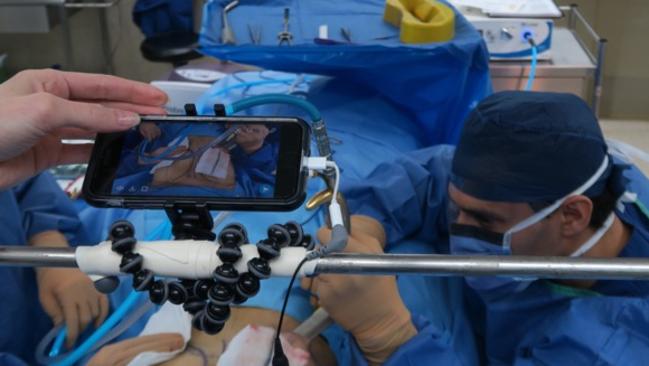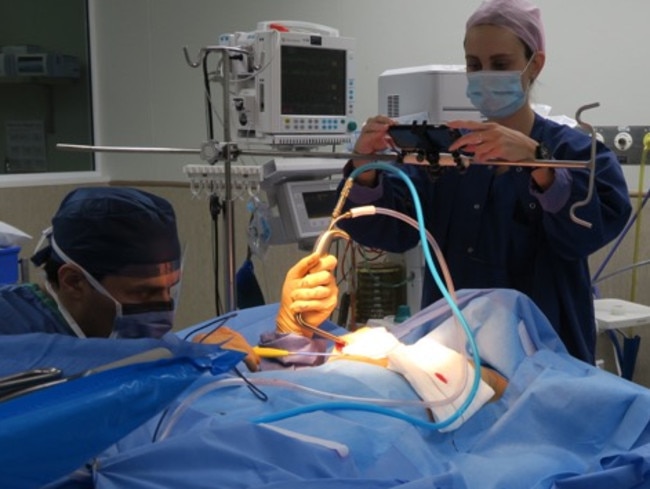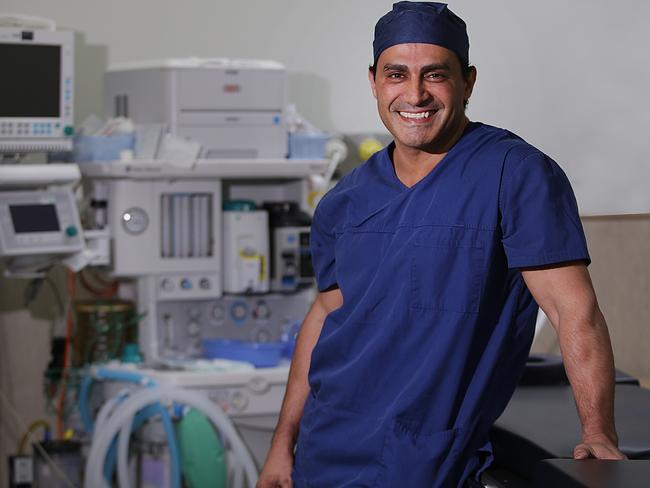Why this plastic surgeon livestreams his operations on Snapchat
THIS Australian plastic surgeon performs breast surgeries, tummy tucks, labiaplasty and buttock enhancements, all while livestreaming on Snapchat.

WARNING: Graphic images
NSW plastic surgeon Eddy Dona is preparing for his next breast augmentation surgery.
His scrubs are on, his tools are in place and his patient is anaesthetised. All that remains to be said is ‘lights, camera, action’. Today Dr Dona is filming his surgery ready to upload to social media.
“I started live streaming my surgeries on Snapchat in September,” says Dr Dona. “I’d been giving it some thought for a while and seeing it first hand in the States cemented my decision.
“A lot of the American surgeons’ footage is more for entertainment purposes as that’s their market, but mine was always going to be about education because that’s what I believe Australia wants.”
Dr Dona currently operates between two to three days per week. During this time, he performs breast surgeries, tummy tucks, rhinoplasty, labiaplasty and buttock enhancements. He also works on skin cancer removal and hand trauma.
Between 30-40 per cent of these surgeries are filmed and uploaded with the patient’s consent.
“Patients want to watch their surgery afterwards as they find it fascinating. But a lot of them also lack knowledge and respect that the footage is educational for them and others,” says Dr Dona.
“The footage is very graphic and that’s how it needs to be. It’s never glamorised or trivialised and by talking viewers through the surgery I’m performing, they’re aware of the risks involved.”

It’s Dr Dona’s belief that by educating people this way, they’ll realise that undergoing surgery is not a quick fix or a decision to be taken lightly.
“It’s too easy to simply show a before and after picture, but what I’m showing is the reality of surgery which is ugly, frightening and graphic. I’m normalising the reality of surgery, not surgery itself. I’m putting people off making an off the cuff decision.”
With a few surgeons already following in Dr Dona’s footsteps, the likelihood is that this social media practice may continue to gain in popularity. However, understandably, it’s not popular with everyone.
The Australian Medical Association recently slammed such surgeons, saying there are serious ethical issues at play.
In an interview with the Daily Telegraph, AMA NSW president Brad Frankum said he disagreed with the idea of surgeons using social media to show off their handiwork.
“I think if surgeons are doing it to try and attract business, then it’s not something as a profession we have encouraged. And if they’re doing it to enhance their reputation or show their work, then I have concerns about the ethics of that,” Dr Frankum said.
Surprisingly, Dr Dona agrees.
“If the AMA are not encouraging it as a marketing platform, I totally understand and agree,” he says.
“I think any health care service’s social media platform needs to be first and foremost about education. Of course, there’s the secondary point being marketing but, from my point of view, that should never be the primary purpose.”

There’s no escaping the fact that body image issues are rated as one of the most common causes of concerns in Australia. Unsurprisingly, this correlates with rising numbers of Australians undergoing cosmetic surgery.
One surgery that’s experienced extreme growth in the past decade is genital cosmetic surgery.
A world-first survey exploring GP experiences of cosmetic female genital surgery revealed that girls as young as 15 are requesting and undergoing labiaplasties and other procedures in Australia. Their concerns relate to their genital size, appearance and/or visibility.
Furthermore, Medicare claims for vulvoplasty and labiaplasty jumped from 707 in the 2002/03 financial year to 1588 in the 2012/13 financial year. Medicare statistics do not include women having their surgical procedures in the private health system, so the true number of genital cosmetic surgery procedures is likely to be higher.
Christine Morgan is the CEO of the Butterfly Foundation, an organisation that supports people with eating disorders and body image issues. She’s concerned about how surgeons are using social media.
“Social media encourages repetitive thoughts around body image. With the likes of surgeons using it, it also becomes an environment where language is substituted with images and there’s no considered conversations,” she says.
As an educational tool, Ms Morgan admits that this type of social media could have a positive impact. However, she says that surgeons need to be aware of negative body images issues.
“I see this practice by surgeons as further complicating a very intense discussion,” she says.
“If people play around with diet or exercise excessively, they’re going to harm their body. Throwing in the attraction to and option of surgery is only adding in another risky behaviour.”
If you, or anyone you know is struggling with an eating disorder or body image concerns, you can call the Butterfly Foundation National Helpline on 1800 33 4673 (ED HOPE).



